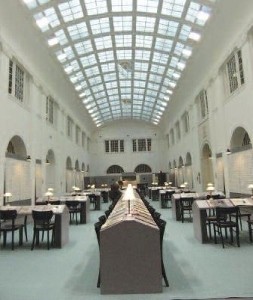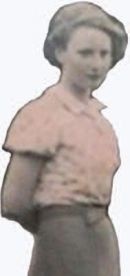Wall-to-Wall Annihilation
A powerful, emotional and thought provoking permanent exhibition of Holocaust memorabilia and personal stories of Berlin Jews transported from that city is on display in an enormous, high walled, glass ceilinged hall of the Berlin-Schöneberg town hall.
A huge cloth banner stretched across the main entrance to the impressive building, rippling in a gentle breeze from one end to the other creating a sort of visual wave, certainly catches one's attention. Apart from 'Wir Waren Nachbarn' printed in large letters across the banner, it was the faces of the young and old former Jewish Berliners stretching across from one corner of the banner to the other, that had one riveted to the pavement as the motion of the gently rippling banner almost made the portraits of those former Berliners come alive - even though many did not survive the Holocaust.
An astounding 4,512 handwritten white index -cards bearing the names and addresses of 6,069 Jewish women, men and children, deported from the Berlin districts of Schöneberg and Friedenau in the years 1941-1945, are displayed on the cream- colored walls of the exhibition hall. Information on the individual cards was taken from 8-16 page asset and tax reports which Jewish Berliners were forced by the Nazis to fill out a short time before their deportation.
Displayed on long wooden, slant-topped desks rest thick files. Each and every one of the 148 files is a biographical album of one of the 55,000 citizens of Jewish descent deported from Berlin. They contain photographs of the individuals, their families, where they lived, copies of letters, official documents and much more. If known, we also share in what was their fate. Many were murdered, others managed to escape to Britain and other countries including Israel.
Berliner Silke Struk, an educator working at the museum, explained about the town hall exhibition and the nearby street sign installation in Schöneberg , which I had visited a short time prior to entering the town hall. Silke Struk is a busy lady dealing with overseas visitors, but also many groups of German high-school pupils, one of which enters as she is explaining to me about the diversity of the people whose lives are remembered in the individual albums. Among them are well-known writers, artists, scientists, athletes and some extremely progressive women, as well as the more stay-at-home family folk, each a world unto his/her own – a world shattered by Hitler's henchmen.
One of the albums is that of Hildegard Basch, who left Berlin in March 1939 for Britain. She was 23 years old. Her family had planned to follow but failed to leave the city in time. Her parents and brother were deported to Auschwitz. They did not survive. A fascinating booklet is chained to the table just above Hildegard Basch's album. The title of the booklet: While you are in England: Helpful Information and Guidance for Every Refugee. Published by The German Jewish Aid Committee, Woburn House in conjunction with The Jewish Board of Deputies, the booklet belonged to Hildegard Basch and was given to the exhibition curators in 2009 by her British born artist daughter, Barbara Loftus, who resides in Brighton.
The Nazis' Finance Offices diligently recorded all assets of the city's Jewish residents. Until 1988 the files, then stored in the main tax office, were only made available to family members of those who had died. Andreas Wilcke, a city administrator of the local district parliament and member of a local cultural institution, was granted access to the files and index cards a year before they were transferred elsewhere, the files eventually ending up at a Potsdam/Brandenburg archive and the index cards at the exhibition hall.
On the thousands of index card wall paper of harrowing times displayed on the walls, one reads details about the families, their address, how many persons had made up that family, their ages and what possessions could be found in their home – down to the very last item, such as towels, bed linen and kitchen utensils.
Reading some of the cold, calculating and neatly detailed index cards about fellow humans who were no longer considered to be that, sent cold chills down my spine.
In an interview with The Guardian newspaper in 2011, Barbara Loftus told how her mother Hildegard Basch had not spoken about her frightening experiences in Berlin until a few years before her death. In her first conversation about the Holocaust with her daughter, the then almost octogenarian spoke of the day, just days after Kristallnacht, when Nazis came to take the family's china and silverware. The family watched as soldiers carefully wrapped each porcelain figurine in tissue paper before placing them inside a wooden chest, and doing the same with the family's items of silver.
In the early 1990s Andreas Wilcke began painstakingly working his way through the index cards in preparation for the town hall exhibition, as well as, together with local politicians, began to prepare plans for a permanent memorial in the Bavarian quarter, an area within Berlin's Schöneberg district. Their tireless efforts resulted in the 1993 Places of Remembrance installation (by artists Renata Stih and Frieder Schnock) being inaugurated. The innovative, creative and powerful installation comprises 80 illustrated street signs attached to lamp posts throughout Berlin-Schöneberg in the area where many Jews had lived (including Albert Einstein before he moved to the United States in 1933).
Places of Remembrance is a permanent exhibition and constant reminder to those walking the streets or residing in present day Schöneberg , of who might have been their neighbors had not it been for the brutal Nazi regime. On one side of each metal street sign is a simple illustration. This may be just a hat, a wall or a pen and paper. On the reverse side of each sign, a line or two of black and white text gives condensed, albeit chilling, versions of rules and regulations passed between 1933 and 1945 to discriminate against, isolate and systematically remove basic rights from Berlin Jewry prior to their deportation and murder.
On the back of the hat sign one reads: Jewish managers can be fired without notice or compensation. November 12, 1938. The wall illustration tells of the March 1939 declaration that Jewish communities are responsible for clearing the rubble at synagogues which have been destroyed. Reconstruction is forbidden. On the back of the illustration showing a pen and paper one is informed of the March 1935 edict: Jewish authors are forbidden from all literary activities in Germany, and another showing a newspaper quote from another ban - on Jewish journalists.
I, an almost 70 year-old British born, Jewish Israeli journalist, reacted particularly strongly to that one, and lingering under the sign, was overcome with a strong desire to yell out who I am and where I am from, and to engage with locals.
However, it was an extremely cold and windy day and except for myself and a good friend accompanying me, there was nobody around to hear my cry.










Comments